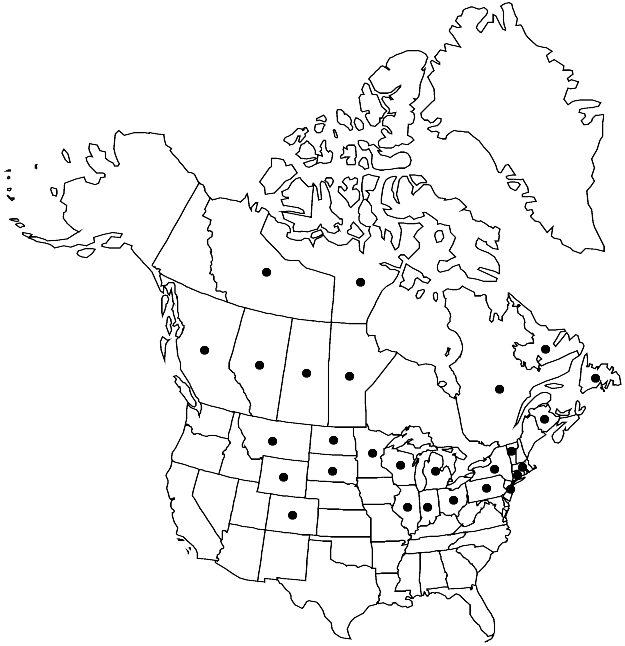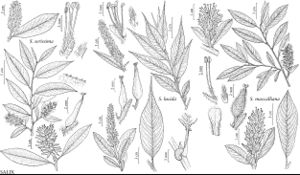Salix serissima
Rhodora 6: 6. 1903.
Shrubs, 1–5 m. Stems: branches usually flexible at base, sometimes brittle, yellowbrown, redbrown, or gray-brown, glabrous, slightly glossy or dull; branchlets yellowbrown or redbrown, glabrous, slightly or highly glossy. Leaves: stipules absent or rudimentary; petiole shallowly to deeply grooved adaxially, 3–13 mm, with pairs of spherical glands distally or throughout, glabrous adaxially; largest medial blade hypostomatous or hemiamphistomatous, narrowly oblong, very narrowly elliptic, elliptic, lanceolate, or narrowly ovate, 43–110 × 9–33 mm, 2.4–6 times as long as wide, base convex or cuneate, margins flat, serrulate, apex acuminate, caudate, or acute, abaxial surface usually not glaucous, sometimes thinly so (appearing pale green), slightly glossy, glabrous, adaxial highly glossy, glabrous; proximal blade margins serrulate or entire; juvenile blade reddish or yellowish green, glabrous abaxially. Catkins: staminate (stout), 25–53 × 12–16 mm, flowering branchlet 5–14 mm; pistillate (fruiting in autumn, often persistent) moderately densely to loosely flowered, stout to globose, 17–42 (–65 in fruit) × 11–22 mm, flowering branchlet 5–32 (–65 in fruit) mm; floral bract (sometimes greenish tawny), 1.2–4 mm, apex acute, rounded, or truncate, glandular-toothed, abaxially moderately densely hairy, hairs straight or wavy. Staminate flowers: abaxial nectary 0.5–1.1 mm, adaxial nectary oblong or ovate, 0.4–1.1 mm, nectaries distinct or connate and cupshaped; stamens 3–9; filaments distinct or basally connate, hairy on proximal 1/2 or basally; anthers ellipsoid or shortly cylindrical, 0.5–0.7 mm. Pistillate flowers: adaxial nectary ovate, oblong, or flask-shaped, 0.3–1.1 mm, shorter than stipe; stipe 1.2–2.4 mm; ovary pyriform to obclavate, beak slightly bulged below or abruptly tapering to styles; ovules 12–16 per ovary; styles connate, 0.3–1 mm; stigmas flat, abaxially non-papillate with rounded tip, or slenderly cylindrical, 0.4–0.7 mm. Capsules 7–12 mm. 2n = 76.
Phenology: Flowering early Jun-early Jul.
Habitat: Wet thickets, fens, brackish marshy strands, marly lakeshores, treed bogs, gravelly stream banks, lakeshores
Elevation: 10-3000 m
Distribution

Alta., B.C., Man., N.B., Nfld. and Labr., N.W.T., Nunavut, Que., Sask., Colo., Conn., Ill., Ind., Mass., Mich., Minn., Mont., N.J., N.Y., N.Dak., Ohio, Pa., S.Dak., Vt., Wis., Wyo.
Discussion
Salix serissima is found in Nunavut only on Akimiski Island in James Bay.
Flowering of Salix serissima is often described as serotinous (i.e., long after leaves emerge), but actually, they flower just as leaves emerge. Although they flower only a little later in spring than related species, they set fruit in late summer, and fruiting catkins often persist throughout winter. Their seeds remain dormant throughout the winter and germinate in the spring, thus enabling them to invade fens by completing their first annual growth before the sedges and grasses are tall enough to shade them out. This strategy has been reported to occur also in the related S. pentandra (A. K. Skvortsov 1999).
North American Salix serissima is closely related to Eurasian S. pseudopentandra (Floderus) Floderus (A. K. Skvortsov 1999), which is known in China as S. pentandra var. intermedia Nakai and possibly also S. humaensis Y. L. Chou & R. C. Chou (Fang Z. F. et al. 1999). The relationship of S. serissima and S. pseudopentandra is similar to that of S. arbusculoides and S. boganidensis (G. W. Argus 1997). These two species, along with the amphiberingian S. vestita, are relictual members of former panboreal distributions.
Hybrids:
Hybrids between Salix lucida and S. serissima have been reported (M. L. Fernald 1950); no convincing specimens have been seen.
Selected References
None.
